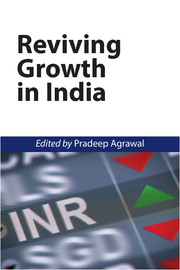Book contents
- Frontmatter
- Contents
- List of Tables and Figures
- Preface
- Section 1 The importance of growth
- Section 2 Reviving growth of industry and exports
- Section 3 The dampeners to growth: Controlling inflation
- Section 4 The supply constraints to growth
- Section 5 Emerging issues in growth: The labour and capital markets
- Chapter 12 Issues in Labour Cost and Employment
- Chapter 13 Financing Structure and Growth: A Study of Firms in the Indian Private Corporate Sector
- Chapter 14 Export Intensity and Dividend Policy of Indian Firms
- Contributors
- Index
Chapter 14 - Export Intensity and Dividend Policy of Indian Firms
from Section 5 - Emerging issues in growth: The labour and capital markets
Published online by Cambridge University Press: 18 December 2015
- Frontmatter
- Contents
- List of Tables and Figures
- Preface
- Section 1 The importance of growth
- Section 2 Reviving growth of industry and exports
- Section 3 The dampeners to growth: Controlling inflation
- Section 4 The supply constraints to growth
- Section 5 Emerging issues in growth: The labour and capital markets
- Chapter 12 Issues in Labour Cost and Employment
- Chapter 13 Financing Structure and Growth: A Study of Firms in the Indian Private Corporate Sector
- Chapter 14 Export Intensity and Dividend Policy of Indian Firms
- Contributors
- Index
Summary
INTRODUCTION
Export-led growth has been a time-honored strategy for many developing countries, most recently in China and in India. The argument is that exports can be an engine for faster growth. Exports allow a country to produce at larger and more efficient scales and to exploit its comparative advantages; furthermore, the development of the export sector could also generate employment opportunities. However, this line of thinking assumes that firms in the export sector are managed efficiently. There is increasing evidence that exporting and profitability are indeed positively correlated. However, most of this research looks at operational characteristics of exporting firms; little research has been done regarding the financial policies of exporting firms.
Exporting firms could also generate resources for further investment from their profits. Nair (2013) documents the increasing dependence of Indian corporate investment on retained earnings. According to corporate finance theory, a firm's decision to retain earnings rather than pay them out in dividends is due to information asymmetry and other capital market frictions. However, arguably recycling of corporate earnings through payment of dividends and subsequent reinvestment is more desirable; the payment of dividends provides more information to the market and allows market participants to value the existing assets of the firm better, leading to more efficient resource allocation. This connection between exports, dividends, and reinvestment suggests the importance of examining the dividend behaviour of exporting firms.
There are many reasons why dividend payout ratios at the firm level should be related to export intensity. First of all, the cashflow volatility theory suggests that more stable firms should be able to pay higher dividends. Shareholders prefer predictability in their dividends and cashflow stability means that firms will not need to cut dividends because of lower profits; given the low correlation between economic activities in developed and developing countries, exporting firms with a mix of domestic and foreign sales would tend to have lower cashflow volatility.
- Type
- Chapter
- Information
- Reviving Growth in India , pp. 358 - 386Publisher: Cambridge University PressPrint publication year: 2015
- 1
- Cited by



